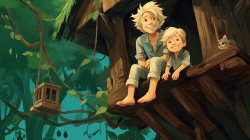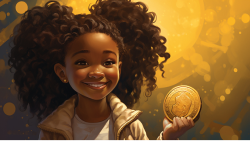READ
By S A Page
A Journey Through History: Storytelling To Children
Storytelling is a fundamental part of human culture and has been for millennia. It is a timeless tradition that spans across generations and serves as a means of passing down knowledge, values, and entertainment. When it comes to storytelling for children, the roots of this art form run deep, evolving over the centuries to captivate young minds and foster imagination. In this blog post, we'll embark on a journey through history to explore the rich history of storytelling to children, from its humble beginnings to the digital age.
.png?alt=media&token=cc44cea7-adb3-4239-afb4-bae5d7a04a9d)
Ancient Beginnings (Prehistory - 5th Century CE)
The origins of storytelling to children can be traced back to prehistoric times when early humans communicated through oral traditions. These stories were often passed down from one generation to the next, serving as a means of preserving history, teaching survival skills, and instilling cultural values.
In ancient civilizations, such as Egypt, Mesopotamia, and Greece, storytelling was a cherished tradition. Epic tales like "The Odyssey" by Homer were recited to captivated audiences, including children. These stories not only entertained but also educated young minds about bravery, heroism, and the world beyond their immediate surroundings.
Medieval Tales and Fables (5th - 15th Century CE)
During the Middle Ages, storytelling to children began to take on more structured forms. Fables, moral tales often featuring talking animals, became popular as they provided valuable life lessons. Aesop's Fables, for instance, taught children about honesty, kindness, and the consequences of their actions.
Medieval Europe also saw the emergence of chivalric romances like "King Arthur and the Knights of the Round Table." These stories, full of daring adventures and noble deeds, inspired a sense of honor and duty in young listeners.
The Golden Age of Fairy Tales (17th - 19th Century CE)
The 17th to 19th centuries witnessed the emergence of fairy tales as a dominant form of storytelling for children. Renowned authors such as Charles Perrault and the Brothers Grimm introduced timeless classics like "Cinderella", "Little Red Riding Hood" and "Snow White". These tales combined magic, adventure, and morality, captivating young audiences while imparting essential life lessons.
The Advent of Children's Literature (19th Century CE)
The 19th century marked a significant shift in storytelling to children with the emergence of children's literature. Pioneers like Lewis Carroll ("Alice's Adventures in Wonderland") and Louisa May Alcott ("Little Women") created stories specifically crafted to engage and entertain young readers.
Additionally, educational reformers like Johann Heinrich Pestalozzi and Friedrich Froebel emphasized the importance of storytelling in early childhood education. This led to the development of teaching methods that incorporated storytelling as a tool for cognitive and emotional development.
The 20th Century and Beyond
The 20th century witnessed a proliferation of children's literature, including the works of Dr. Seuss, Maurice Sendak, and J.K. Rowling. Moreover, the advent of radio, television, and eventually the internet opened up new avenues for storytelling to reach children in innovative ways. Animated films, interactive apps, and audiobooks have all become valuable mediums for engaging young audiences.
Today, storytelling to children has evolved into a diverse and dynamic art form. It continues to play a vital role in education, entertainment, and character development, with a wealth of multicultural stories and digital platforms catering to a global audience.
To Conclude...
The history of storytelling to children is a testament to the enduring power of narrative in shaping young minds. From its humble beginnings in oral traditions to the digital age, storytelling has evolved to become a cherished and indispensable part of childhood. It not only entertains but also educates, instills values, and fosters creativity, ensuring that the art of storytelling will continue to thrive for generations to come.
Check out our ever expanding library (new releases every Sunday!) of free children’s bedtime stories available in written format here, or fully narrated on YouTube. If you’d prefer physical books or want to support us, then please check out our seasonal collection books - perfect for reading at bedtime - available exclusively on Amazon.


.png?alt=media&token=31638b77-c853-49e9-a536-9e8cfb02b5cc)